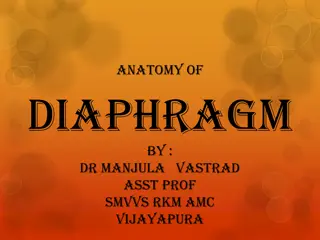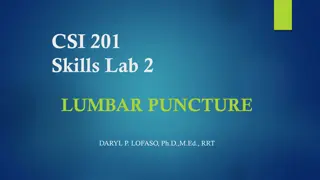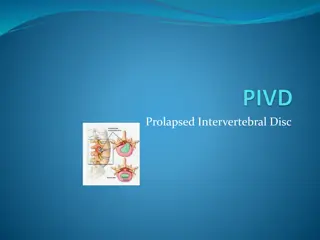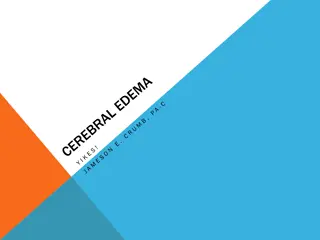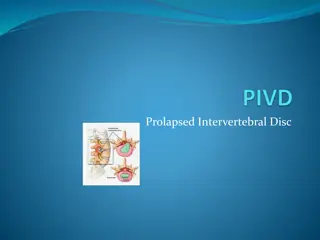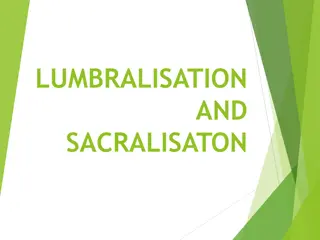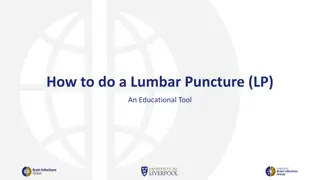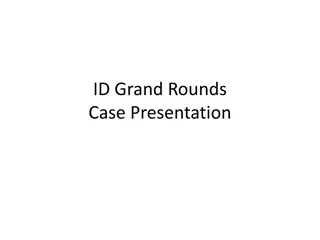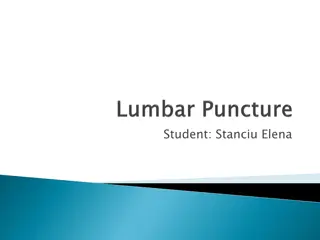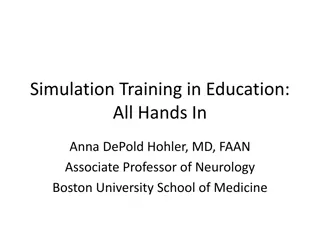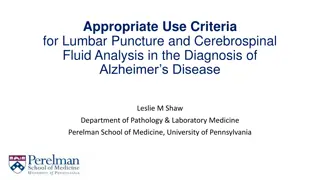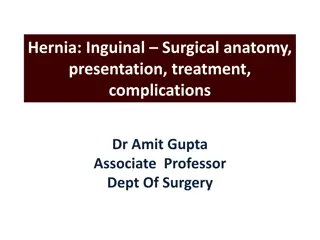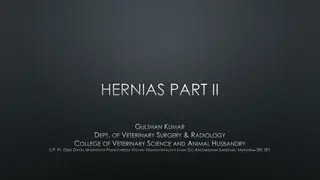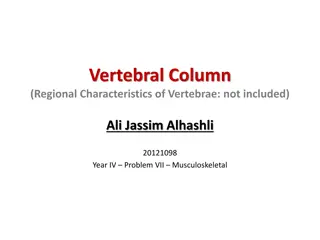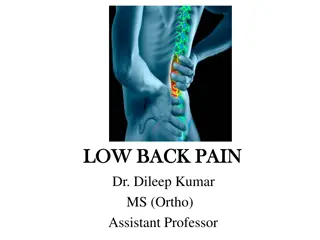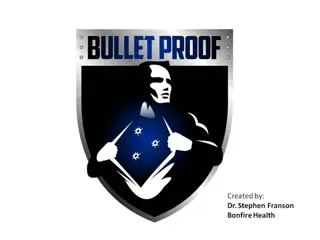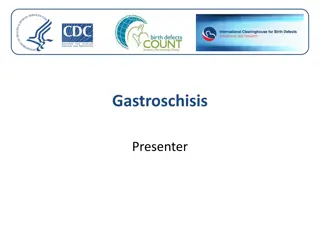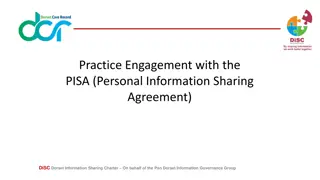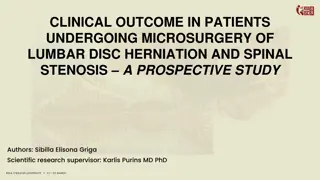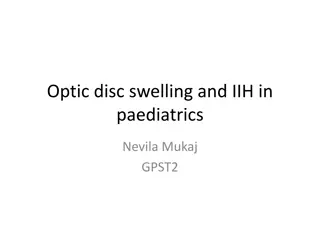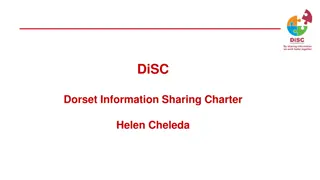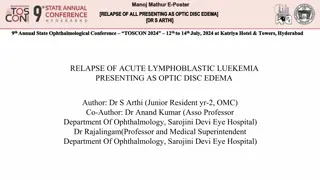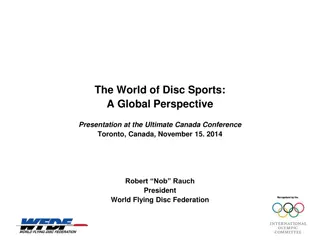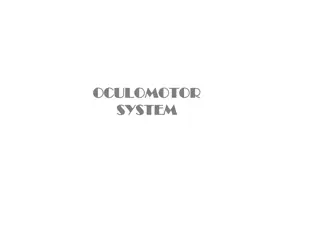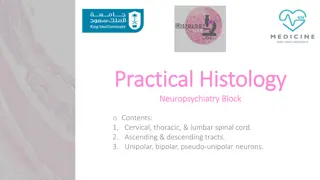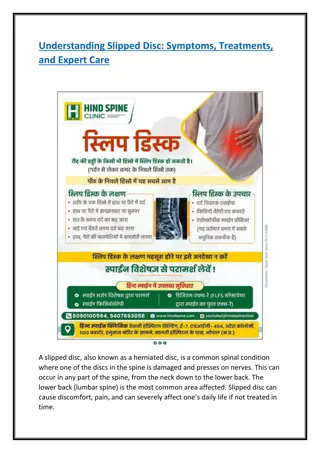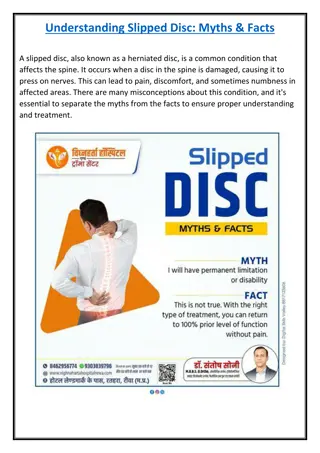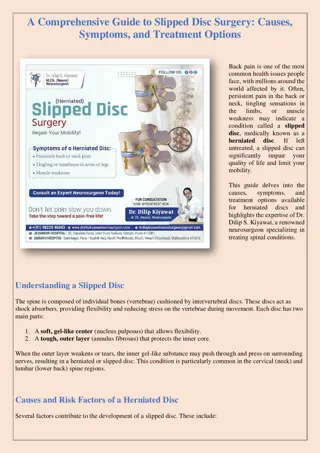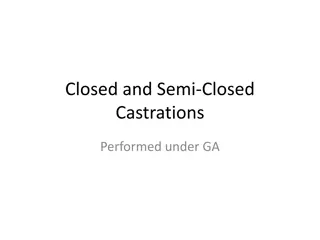Management of Adult Vertebral Disc Infections: SPILF Guidelines Update
Infections of the vertebral discs in adults, or IDV, require prompt diagnosis and treatment based on the latest SPILF guidelines. Key aspects include the importance of disc biopsies if blood cultures are negative, assessing spinal stability by a spine specialist, and utilizing MRI for comprehensive
1 views • 25 slides
Understanding Hydrocollator Packs for Moist Heat Therapy
Hydrocollator packs are a form of superficial heat modality that utilize moist heat to transfer energy to the skin through conduction. These packs, filled with silica gel like bentonite, provide soothing heat for 30-40 minutes when heated in a hydrocollator unit. They come in various sizes and shape
8 views • 11 slides
Anatomy of the Diaphragm: Structure, Function, and Clinical Relevance
The diaphragm, a key muscle of respiration, separates the thoracic and abdominal cavities and plays a crucial role in breathing. This dome-shaped musculofibrous partition originates from various structures such as the xiphoid process, lower ribs, and lumbar vertebrae. Its actions are essential for t
1 views • 29 slides
Lumbar Puncture Procedure Overview
Understand the indications and contraindications, checklist, equipment required, needle passage layers, consent procedures, CSF testing, and key steps like patient positioning for a lumbar puncture. Learn about obtaining CSF, administering medications, measuring ICP, diagnosing CNS infections, and m
0 views • 13 slides
Understanding Prolapsed Intervertebral Disc (PIVD)
The intervertebral disc, a crucial component of the spine, can be affected by prolapse, leading to various stages of PIVD. The condition involves the nucleus pulposus bulging out due to tears in the annulus fibrosis. The stages of PIVD include bulging disc, protrusion, extrusion, and sequestrization
0 views • 36 slides
Understanding Cerebral Edema: Causes, Treatments, and Pathophysiology
Cerebral edema is a life-threatening condition that can result from various factors such as trauma, infarction, hemorrhages, or tumors. This condition can lead to increased morbidity and mortality due to hemorrhage or herniation. New advances in understanding the pathophysiology of cerebral edema ha
1 views • 28 slides
Understanding Post-Dural Puncture Headache in Children
Post-dural puncture headache (PDPH) is a common complication following lumbar puncture, characterized by a positional headache that worsens when upright and improves when lying flat. This article discusses the epidemiology, etiology, diagnosis, risk factors, management, and treatment of PDPH in chil
0 views • 30 slides
Understanding Prolapsed Intervertebral Disc (PIVD) and its Stages
The article explores the anatomy of intervertebral discs, definition of spinal disc prolapse, stages of PIVD (bulging disc, protrusion, extrusion, sequestration), and provides detailed insights into each stage with corresponding images. Readers can gain a comprehensive understanding of PIVD and its
0 views • 36 slides
Understanding Lumbarisation and Sacralisation in Human Spine
The human spine comprises the cervical, thoracic, lumbar, sacral, and coccyx vertebrae. Lumbarisation refers to the non-fusion of the uppermost sacral segment, while sacralisation involves fusion of the fifth lumbar vertebra with the sacrum. Lumbarisation can cause issues such as back pain, inflamma
0 views • 14 slides
Lumbar Puncture (LP) Educational Tool Overview
This educational tool provides information on how to perform a lumbar puncture (LP) for brain infections. It covers learning objectives, contraindications, and steps involved in the procedure. The content includes visuals and notes to enhance understanding and adaptation.
0 views • 26 slides
Understanding Degenerative Spine Disease and Disc Degeneration
Degenerative spine disease is a prevalent condition affecting millions, leading to substantial healthcare costs. The anatomy and physiology of spine degeneration involve the three-joint complex theory. Pathologically, disc degeneration impacts the nucleus pulposus and annulus fibrosis, contributing
0 views • 37 slides
Confusion and Stroke: A Challenging Case Presentation in the Emergency Department
A patient with a history of cerebral aneurysm presented to the Emergency Department with confusion and hiccups. Despite initial stability, imaging revealed findings suggestive of a possible stroke. Further studies including cEEG and lumbar puncture were performed. The MRI findings indicated restrict
0 views • 11 slides
Lumbar Puncture: Procedure, Complications, and Clinical Applications
Lumbar puncture, also known as LP, is an invasive procedure used to obtain cerebrospinal fluid (CSF) for diagnostic and therapeutic purposes. This procedure has a long history dating back to ancient times, with modern techniques developed in the late 19th century by Heinrich Quincke. LP is crucial f
2 views • 11 slides
Lumbar Puncture: Indications, Contraindications, and Post-procedure Considerations
Lumbar puncture is a medical procedure involving the insertion of a needle into the spinal subarachnoid space to collect cerebrospinal fluid for diagnostic or therapeutic purposes. Indications for performing a lumbar puncture include suspicion of meningitis, subarachnoid hemorrhage, CNS diseases lik
0 views • 17 slides
Simulation Training in Education: Enhancing Learning Through Hands-On Simulation
Hands-on simulation training in education provides students with valuable learning experiences by increasing self-reported knowledge and technical proficiency. Simulations help improve students' knowledge, experience, and comfort with challenging procedures in a lower-risk environment, leading to en
0 views • 13 slides
Appropriate Use Criteria for Lumbar Puncture in Alzheimer's Disease Diagnosis
Clinicians traditionally diagnose Alzheimer's Disease (AD) based on clinical criteria, but cerebrospinal fluid (CSF) AD biomarkers offer more reliable detection earlier in the disease course. This article discusses the criteria for lumbar puncture and CSF analysis in the diagnosis of AD, highlightin
0 views • 18 slides
Understanding Spinal Canal Stenosis: Causes, Symptoms, and Classification
Spinal canal stenosis is the abnormal narrowing of the spinal canal or intervertebral foramina, leading to compression of nerves and blood vessels. It can result in symptoms such as radiculopathy, claudication, myelopathy, and more. Cervical stenosis presents with arm pain and weakness, while lumbar
0 views • 18 slides
Comprehensive Overview of Inguinal Hernia: Anatomy, Presentation, and Treatment
Inguinal hernia is characterized by an abnormal protrusion of viscus or a part of it through a weak point in the abdominal wall. It involves the anatomy of the inguinal region, including the superficial and deep inguinal rings, inguinal canal boundaries, and defense mechanisms. The anatomical classi
0 views • 37 slides
Understanding Perineal Hernias in Veterinary Surgery
Perineal hernias are a common condition in uncastrated males but can also occur in females and cats. Weakness in the pelvic diaphragm can lead to herniation due to factors like hormonal disorders, prostatic diseases, and rectal issues. The symptoms include swelling in the perineal region, and diagno
0 views • 25 slides
Understanding the Vertebral Column and Abnormal Curvatures
The vertebral column, extending from the cranium to the coccyx, plays vital roles in protecting the spinal cord, providing support, and facilitating movement. It consists of 33 vertebrae arranged in 5 regions, each with specific functions and characteristics. The column's curvatures, including cervi
0 views • 12 slides
Understanding Low Back Pain: Causes, Epidemiology, and Management
Low back pain is a prevalent issue affecting adults globally, with lumbar disc disease and poor posture being significant contributors. This condition can result from various factors, leading to discomfort in the lower back region. Understanding the epidemiology, common and uncommon causes, as well
0 views • 61 slides
Understanding Back Pain: Causes, Symptoms, and Treatment Options
Explore the comprehensive guide on back pain, covering its causes, symptoms, and various treatment options available. Learn about conditions like sciatica, disc herniation, subluxation, and alternative therapies. Discover insights on nerve supply, less-known facts like nerve pain perception, and dia
0 views • 26 slides
Understanding Gastroschisis: Clinical Features, Epidemiology, and Etiology
Gastroschisis is a birth defect involving herniation of intestines outside the abdomen. This presentation covers clinical features, epidemiological aspects like prevalence rates and risk factors, along with insights into its etiology. Learn to differentiate gastroschisis from omphalocele, recognize
0 views • 14 slides
Gait Device Selection for Children with Lumbar Level Myelomeningocele
This presentation discusses the considerations and choices of gait devices for children with lumbar level myelomeningocele. It covers the specific needs of pediatric patients, benefits and drawbacks of various devices, funding requirements, and clinical application through case studies. The material
0 views • 31 slides
Enhancing Information Sharing: DISC and PISA Benefits
DISC (Dorset Information Sharing Charter) and PISA (Personal Information Sharing Agreement) facilitate improved information sharing among healthcare organizations in Dorset. DISC establishes robust principles for managing data flow and promoting best practices in information governance, while PISA t
0 views • 8 slides
Clinical Outcomes in Microsurgery for Lumbar Disc Herniation: Prospective Study
This prospective study examined the clinical outcomes in patients undergoing microsurgery for lumbar disc herniation and spinal stenosis. The study evaluated the effectiveness of surgical intervention using the Oswestry Disability Index (ODI) and Numeric Rating Scale (NRS) questionnaires preoperativ
0 views • 13 slides
Optic Disc Swelling and IIH in Paediatrics: A Case Study of Papilloedema in a 12-year-old Female
This case study presents a 12-year-old female who was referred for papilloedema with symptoms of headaches, intermittent vomiting, and blurred vision that worsens upon getting up. She had no history of trauma, diplopia, or significant medical conditions. Examination revealed optic disc swelling, hyp
0 views • 44 slides
DiSC Dorset Information Sharing Charter Overview
The DiSC Dorset Information Sharing Charter, initiated by the Better Together programme, aims to improve information sharing for patients, residents, and service users in Dorset. It ensures a collaborative approach with an overarching governance and quality assurance structure. With over 100 members
0 views • 7 slides
Relapse of Acute Lymphoblastic Leukemia presenting as Optic Disc Edema at TOSCON 2024
At the 9th Annual State Ophthalmological Conference (TOSCON) in 2024, Dr. S. Arthi presented a case of a 21-year-old male with a history of Acute Lymphoblastic Leukemia (ALL) who experienced a relapse presenting as optic disc edema. Despite chemotherapy and being under remission, the patient develop
0 views • 6 slides
Overview of Tax Incentive Strategy for U.S. Exporters by Edward K. Dwyer, CPA
This presentation by Edward K. Dwyer, a renowned CPA, delves into the tax incentive strategies for U.S. exporters, focusing on the Interest Charge Domestic International Sales Corporation (IC-DISC). It covers the historical background, recent legislative impacts, IC-DISC requirements, intercompany p
0 views • 31 slides
Efficient Algorithms for Finding the Smallest Enclosing Disc
Explore algorithms for finding the smallest enclosing disc for a given set of objects, optimizing central placement, and ensuring minimal distance from objects. The process involves identifying critical steps, computations for passing through points, and analysis highlighting linear running times. D
0 views • 14 slides
The Evolution of Flying Disc Sports: A Global Perspective
Explore the fascinating history and development of flying disc sports, from the early days of Frisbee to the formation of the World Flying Disc Federation. Learn about key milestones, organizations, and the global impact of disc sports. Discover how these sports have evolved and gained recognition w
0 views • 50 slides
Understanding the DISC Personality Profiles
The DISC model, developed by William Moulton Marston, categorizes individuals into four behavioral styles based on whether they are people-oriented or task-oriented, as well as reserved or active. The Dominant (D) style is assertive and decisive, Influential (I) style is charismatic and motivating,
0 views • 9 slides
Understanding Disc Prolapse and Degenerative Changes in the Spine
Intervertebral discs are crucial gel-like cushions between vertebrae that absorb shock and allow spinal flexibility. Disc prolapse, wear and tear, and spondylosis are common issues, with types like focal and broad-based herniation explained. The axial localization of herniated discs and imaging meth
0 views • 33 slides
Oculomotor System Disorders Overview
Oculomotor system disorders encompass a range of conditions affecting the intricate network involving the oculomotor nerve and associated structures. From nuclear IIIrd nerve palsies to fascicular syndromes and uncal herniation syndrome, various pathologies can disrupt eye movement control and pupil
0 views • 13 slides
Practical Histology: Spinal Cord Tracts and Neurons Overview
This practical histology guide covers the cervical, thoracic, and lumbar spinal cord segments, along with ascending and descending tracts, and pseudo-unipolar/unipolar neurons. It emphasizes key features such as the ventral and dorsal horns, gracile and cuneate tracts, and provides essential informa
1 views • 12 slides
Understanding Slipped Disc Hind Spine Clinic
If you're looking to understand and treat a slipped disc in Bhopal, Hind Spine Clinic, led by Dr. Raghvendra Raghuvanshi, offers specialized care and guidance. A slipped disc, also known as a herniated disc, can cause significant back pain and discom
2 views • 4 slides
Understanding Slipped Disc Vighnharta Hospital
A slipped disc, also known as a herniated disc, is a common spine problem that can cause significant discomfort and impact daily activities. There are many myths surrounding this condition, leading to confusion and unnecessary worry. At Vighnaharta H
3 views • 5 slides
Slipped Disc Surgery in pune - Dr. Dilip Kiyawat
This is an informational flyer about Dr. Dilip S. Kiyawat, a neurosurgeon specializing in herniated (slipped) disc surgery. It highlights symptoms like persistent back pain, tingling, and muscle weakness. It encourages consultation for regaining mobi
1 views • 4 slides
Closed and Semi-Closed Castrations Techniques in Veterinary Surgery
Detailed instructions and images depicting the methodology for performing closed and semi-closed castrations in animals under general anesthesia. The closed technique involves incising the scrotum and ligating the spermatic cord, while the semi-closed method involves extruding the testicle and ligat
0 views • 9 slides


